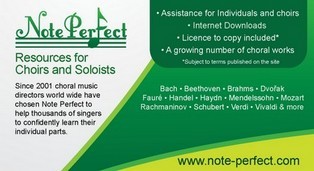Silent Night - (arr Mather)
Carols
| Music: | Franz Xaver Gruber | |
| Arranger: | R, Mather | |
| Voicing: | SATB and Descant | |
| Words: | Josef Mohr |
Silent night, holy night,
all is calm, all is bright
round yon virgin mother and child.
Holy infant, so tender and mild,
sleep in heavenly peace,
sleep in heavenly peace.
all is calm, all is bright
round yon virgin mother and child.
Holy infant, so tender and mild,
sleep in heavenly peace,
sleep in heavenly peace.
Silent night, holy night,
shepherds quake at the sight;
glories stream from heaven afar,
heavenly hosts sing Alleluia!
Christ the Saviour is born,
Christ the Saviour is born!
shepherds quake at the sight;
glories stream from heaven afar,
heavenly hosts sing Alleluia!
Christ the Saviour is born,
Christ the Saviour is born!
Silent night, holy night,
Son of God, love's pure light;
radiant beams from thy holy face
with the dawn of redeeming grace,
Jesus, Lord, at thy birth,
Jesus, Lord, at thy birth.
Son of God, love's pure light;
radiant beams from thy holy face
with the dawn of redeeming grace,
Jesus, Lord, at thy birth,
Jesus, Lord, at thy birth.
Silent night, holy night,
wondrous star, lend thy light;
with the angels let us sing,
Alleluia to our King;
Christ the Saviour is born,
Christ the Saviour is born!
wondrous star, lend thy light;
with the angels let us sing,
Alleluia to our King;
Christ the Saviour is born,
Christ the Saviour is born!
View or download the score
Silent Night 2 arr R. Mather
00:00
Libera
Christ Church Choir, Palayam, Trivandrum, India
Silent Night (“Stille Nacht”) is a popular Christmas carol. The original lyrics of the song Stille Nacht were written in German by the priest Father Josef Mohr and the melody was composed by the Austrian headmaster Franz Xaver Gruber. The version of the melody that is generally sung today differs slightly (particularly in the final strain) from Gruber’s original.
History
The carol was first performed in the Nicola-Kirche (Church of St. Nicholas) in Oberndorf, Austria on December 24, 1818. Mohr had composed the words much earlier, in 1816, but on Christmas Eve brought them to Gruber and asked him to compose a melody and guitar accompaniment for the church service.In his written account regarding the composition of the carol, Gruber gives no mention of the specific inspiration for creating the song. According to the song’s history provided by Austria’s Silent Night Society, one supposition is that the church organ was no longer working so that Mohr and Gruber therefore created a song for accompaniment by guitar. Silent Night historian, Renate Ebeling-Winkler says that the first mention of a broken organ was in a book published in the U.S. in 1909.Some historians believe that Mohr simply wanted a new Christmas carol that he could play on his guitar. The Silent Night Society says that there are “many romantic stories and legends” that add their own anecdotal details to the known facts.The Nicola-Kirche was demolished in the early 1900s due to flood damage and because the town’s centre was moved up the river to a safer location, with a new church being built there close to the new bridge. A tiny chapel, called the “Stille-Nacht-Gedächtniskapelle” (Silent Night Memorial Chapel), was built in the place of the demolished church and a nearby house was converted into a museum, attracting tourists from all over the world, not only but primarily in December.The original manuscript has been lost, however a manuscript was discovered in 1995 in Mohr’s handwriting and dated by researchers at ca. 1820. It shows that Mohr wrote the words in 1816 when he was assigned to a pilgrim church in Mariapfarr, Austria, and shows that the music was composed by Gruber in 1818. This is the earliest manuscript that exists and the only one in Mohr’s handwriting. Gruber’s composition was influenced by the musical tradition of his rural domicile. The melody of Silent Night bears resemblance to aspects of Austrian folk music and yodelling.Another popular story claims that the carol, once performed, was promptly forgotten until an organ repairman found the manuscript in 1825 and revived it. However, Gruber published various arrangements of it throughout his lifetime and we now have the Mohr arrangement (ca. 1820) that is kept at the Carolino Augusteum Museum in Salzburg.It is believed that the carol has been translated into over 300 languages and dialects around the world, and it is one of the most popular carols of all time. It is sometimes sung without musical accompaniment. Although written by Catholics, it is given special significance in Lutheranism.The song was sung simultaneously in English and German by troops during the Christmas truce of 1914, as it was one of the few carols that soldiers on both sides of the front line knew.
This article is licensed under the GNU Free Documentation License. It uses material from the Wikipedia article "Metasyntactic variable".
Comments
Please make comment on the score and music here.
- Keep to the topic of the music on this page. Be polite, comments are moderated
- Tell us where you have used this music and if your performance is published on the internet, please put a link to it in the website field
- Give performance advice/suggestions
- Ask others questions about performance techniques
- Please do not make requests for music on this page
- Your email address is not published
0
reviews
Our sponsors
Other Carols
